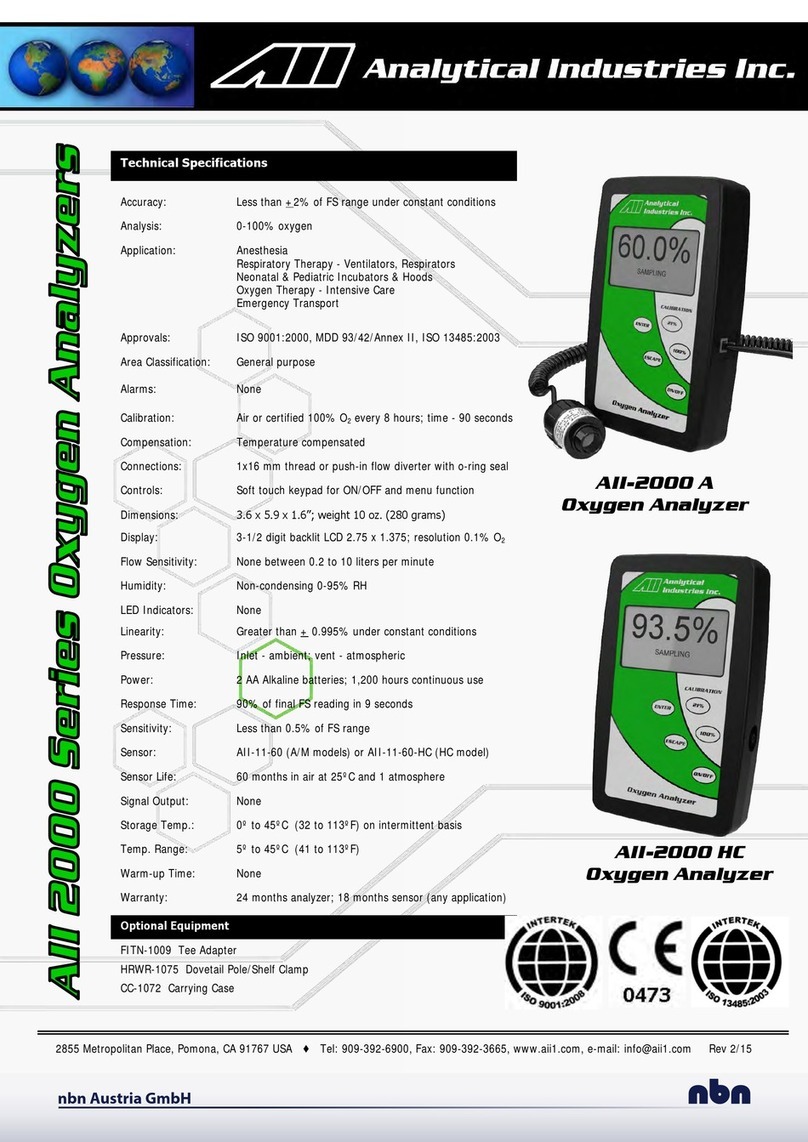12
5 Operation
5.1 Principle of Operation
The AII-2000 Palm O2 Oxygen Analyzer utilizes an electrochemical galvanic fuel
cell type oxygen sensor of the type that is extensively used to measure oxygen
concentrations from 0% to 100% in gas streams. Oxygen, the fuel for this
electrochemical transducer, diffusing into the sensor through a gas permeable
membrane reacts chemically at the sensing electrode to produce an electrical
current output proportional to the oxygen concentration in the gas phase. The
sensor has an absolute zero meaning that when no oxygen is present to be
chemically reacted the LCD displays 00.0 oxygen.
The sensor’s signal output is linear over the entire range, remains virtually con-
stant over the specified useful life and drops off sharply at the end. The sensor
itself requires no maintenance and is simply replaced at the end of its useful life
like a battery. Inasmuch as the sensor is a transducer in its own right, its ex-
pected life is not affected by whether the analyzer is ON or OFF.
The relationship between the sensor’s signal and changes with the oxygen
concentration is both proportional and linear, thus allowing single point
calibration. Other factors that can affect the signal output are described
in Section 5.2 Application Considerations and Section 3 Safety Warnings
which should be read before use.
Historically, the expected life of galvanic fuel type sensors has been specified as
“in air (20.9% O2) at 25°C and 760mm Hg”. The actual life of any galvanic fuel
type sensor is inversely affected by changes in the average oxygen concentra-
tion, temperature and pressure it is exposed to during its useful life. For exam-
ple, the AII-11-75-PO2 and AII-11-75-PO2R sensors have a 32 month expected
life in air (20.9% oxygen) at 25°C and ambient pressure, however, in a 100%
oxygen atmosphere the expected life is 12.6 months [60mo/(100%/20.9%)].
AII-2000 Palm O2 Oxygen Analyzer is battery powered by (2) AA alkaline bat-
teries and controlled by a state-of-the-art microprocessor. The batteries provide
enough power to operate the analyzer continuously for approximately 13,000
hours. Both devices utilize a membrane type keypad for users to communicate
commands to the microprocessor. The digital electronics provide features such
as system diagnostics and warning indicators that enhance both safety and
effectiveness. The design criteria, quality program and performance features
ensure reliable and accurate oxygen measurements.
13
5.2 Application Considerations
Effect of Anesthetic Agents
The AII-2000 Palm O2 Oxygen Analyzer utilizes an electrochemical galvanic
fuel cell type sensor, model AII-11-75-PO2, that has been characterized by its
gas permeable sensing membrane that allows the gas to be analyzed to diffuse
into the sensor where oxygen can be reacted. The displayed oxygen concentra-
tion of all sensors of this design decreases in the presence of anesthesia gases.
EN 12598:1999/ISO 7767:1997 (E) established standards for the maximum
error allowable over a given duration. The anesthetic agents listed (Halothane,
Enflurane, Isoflurane, Sevoflurane and Desflurance) were vaporized into a gas
stream of 30% oxygen / 70% nitrous oxide.
Gas Test Level Decrease in O2 Reading
Helium 50%, Balance O2 0%
Nitrous Oxide 80%, Balance O2 0%
Carbon Dioxide 10%, Balance O2 0%
Halothane 4% <-1.5%
Enflurane 5% <-1.5%
Isoflurane 5% <-1.5%
Sevoflurane 5% <-1.5%
Desflurane 15% <-1.5%
The errors listed were observed after a two (2) hour exposure period. The
table above summarizes the performance of the AII-2000 Palm O2 electronics
and AII-11-75-PO2 Oxygen Sensor. The above performances all meet or ex-
ceed the requirements established by EN 12598:1999/ISO 7767:1997 (E).
Do not operate any device in the presence of flammable anesthetic agents
such as Diethal Ether or Cyclpropane.
Note: The AII-11-75-PO2 Oxygen Sensor has been specifically designed and
tested to be compatible with nitrous oxide. For optimum results, mount oxygen
sensor with the sensing area facing down toward the floor and be flushed or
calibrated with 100% oxygen every eight (8) hours.
Effect of Temperature
All membrane clad electrochemical sensors are temperature dependent due to
the expansion and contraction of the Teflon sensing membrane. As result more
or less of the sample gas including oxygen to be reacted diffuses into the sen-
sor. The oxygen sensor’s electrical current signal output varies linearly with
oxygen concentration. The signal also varies with changes in ambient tempera-
ture. The temperature coefficient is typically 2.54% of the signal or reading per
degree C change in temperature.




























